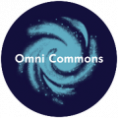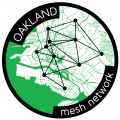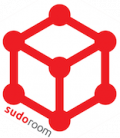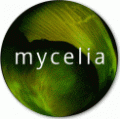|
|
On December 2nd, as soon as the purchase of the Omni Commons was finalized (!!!), I packed up my car and took off for the Standing Rock Sioux reservation (located about 1600 miles northwest) with a comrade to join the fight against the Dakota Access Pipeline. Over the previous two months, I’d been looped into the Tech/Comms team on the ground via another comrade, Lisha Sterling from Geeks Without Bounds, and had been advising on building out a local area or mesh network to help with connectivity and communications issues on the ground.
We arrived during one of the more tumultuous times at camp, as the population had spiked to over 12,000 people – many of them hugely unprepared and underequipped for the arctic conditions of North Dakota in December. It was an intense experience personally for many in our community – halfway through our trek across the country, friends and relatives reached out with horrific news: over 30 people, most of them young artists and activists embedded in the social fabric of our lives in Oakland, had perished in the tragic Ghostship warehouse fire that weekend.
So we arrived, shaken and heartbroken and more than a little sick of each other’s company to boot. The final miles of our journey into camp were a slow crawl behind hundreds upon others who’d come in solidarity – but just as many hundreds of vehicles headed out of camp. Apparently, the judge had denied the easement that would enable DAPL to continue constructing the pipeline that month, and approximately half the camp concluded this was a victory. We arrived to a bewildering scene: reuniting with brokenhearted friends from Oakland, firework celebrations and partying over a perceived victory we knew was short-sighted, and the first dangerously-low temperature dip of the season: -10°F (-23°C). Over 30 people that night were reported by Medical as hypothermic.
I was so incredibly grateful when Lisha greeted me with news that the Tech Tent had just been outfitted with a stovepipe, and that bunkbed cots were on the way. After spending my first day getting oriented and making the Tech Tent habitable, I recorded my first livestream:
That week, given the timing, was largely spent orienting myself, trying to understand what the fuck was going on with continual actual threats as well as false alarms triggered by the State, constantly-shifting internal community power dynamics, and multiple small emergencies daily (such as bringing a generator to a camp whose horse trough had frozen over). Lisha was horrifically sick with a bronchial infection (as were many at camp, thanks to a killer combo of cold, smoke, and stress), and the majority of the tech crew had just left. I found myself faced with one of the more challenging set of circumstances I’ve experienced in my life: rapidly adapting to extreme and unfamiliar conditions whilst balancing the need to listen and deeply understand a sacred space and struggle with the call for active leadership on the technical and communications front.
It was bitterly ironic to be burning wood and propane when we had an abundance of resources for building a sustainable energy grid – then again, these were critical environmental and psychological conditions unlike most anyone has ever known. At times, it was hard to think about anything other than how to warm one’s fingertips. Nevertheless, I was staying in a comparably toasty tent full of solar panels, wind turbines, and radio equipment – hella privileged, I had to admit, as I hauled hay bales generously donated from the back of the Wellbeing Tent to provide a layer of insulation around the Tech Tent. We had a stockpile of much-needed gear, but not much in the way of a crew capable of deploying it. So, I set out to build a crew – focusing first and foremost on power.
As is often the case in communities bound together by a unifying cause in the face of a powerful enemy, it didn’t take long to find the others. By the end of the week, we had a skeleton crew of smart, capable techies making the Tech Tent one of their home bases, had inventoried and tested our equipment, and had begun to deploy power crews to most-needed locations whilst collating a map and a plan for the rest of the camp.
A week or so into my arrival, the main public hotspot (a Ubiquiti NanoStation M5 running on stock firmware with a point-to-point connection to the Wellbeing Tent at the base of Media Hill) disappeared from its semi-prominent location at the dome in what was clearly an act of sabotage:
Luckily, I’d brought a few routers (MyNet N600s) already pre-flashed with the sudomesh firmware. I set one up in the Wellbeing Tent with a direct ethernet cable connection to the directional antenna receiving internets from the hill, and another one inside the dome. With a range of ~100 meters, the two nodes were able to see each other and mesh easily. Both tents now hosted open peoplesopen.net hotspots in addition to the private ssid at the Wellbeing Tent, the password for which was distributed to indigenous leadership as well as the tech and media crews.
A few days later, I met a comrade from Sacred Stone who shared some footage of sabotage they’d uncovered at the other end of camp – a perfect-condition snowplow destroyed by way of removing a critical part; additionally, several power lines and insulated water pipes destroyed. But the sabotage was merely the tip of the iceberg of psychological warfare waged against the Water Protectors – from the fire hoses in sub-zero temperatures to the nonstop, creepy trolling of all of our walkie-talkie channels, there was no possibility of escape from it.
I wasn’t at Standing Rock long – a mere two weeks, buffeted by the Omni building purchase into December and a long-planned trip to Africa with my partner’s family at the end of the month – but I learned more in those two weeks than I can even begin to articulate in this post. The importance of trust (AND paranoia) in liminal spaces of contention, maintaining internal peace in the face of at-times violent chaos, organizing with humans who’ve reached their physical and psychological limits, carrying on and doing what needs to be done when all hope seems lost, and ultimately, finding grounding and humility in serving the indigenous leadership protecting and honoring Maka Ina – Earth Mother.
My final livestream, sounding much hoarser and wearier:
This summer marked the 8th annual Battle of the Mesh in beautiful Maribor, Slovenia at the foot of the Swiss alps. Each year, folks from around the world who work on open source mesh networking protocols (schemes for routing packets across a network) and community wireless networks converge to deploy a testbed mesh network, running different protocols on top of it and analyzing which of them perform the best.
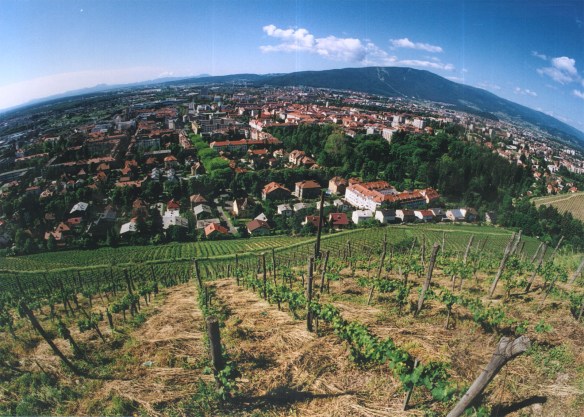 Mount Pohorje in Maribor, Slovenia, site of BattleMesh v8! This year, the conference agenda also included a wider variety of topics, from decentralized and secure file systems and applications to political discussions about the future of open hardware and firmware in the face of imminent federal regulatory lockdown measures.
The first day was largely spent socializing and setting up the topology of the network:
 Topology of the testbed network built at BattleMesh v8 Five actively maintained and deployed routing protocols were tested over the course of the week:
* Babel, a distance-vector routing protocol for IPv6 and IPv4 largely developed by Juliusz Chroboczek in France;
* Batman-adv, an implementation of BATMAN [Better Approach to Mobile Ad-hoc Networking], spearheaded by the Germany-based Freifunk community;
* BMX7, an experimental protocol designed to bridge Layer 2 and Layer 3 routing;
* OLSRd1, short for ‘Optimized Link State Routing’ and widely utilized in many of community networks due to its stability, scalability and active development community,
* OLSRd2, a new iteration of OLSR designed to be more modular and flexible, published by the IETF in 2014.
Day 2 started out rather chaotically, as a dozen wireless hackers attempted to fix the internet they’d borked. The afternoon’s talks featured an excellent presentation by Julius, the lead developer of Babel, entitled ‘babel does not care.’ You can watch the talk (with accompanying slides) here. Julius’ talk was followed by a presentation of GNUnet, a free-as-in-freedom alternative and privacy-conscious network for peer-to-peer filesharing, VOIP communication, and peer discovery that works over a variety of transport mechanisms. Watch the full talk with slides here. Next, Elektra of Freifunk gave a presentation on the current state of TV whitespace spectrum and the potential future applications of UHF. I highly recommend watching the talk, as Elektra concludes with a stirring call-to-action for the community to engage with the political struggle over spectrum allocation, one unfairly slanted toward powerful telecommunications companies over free and open community network usages.
Day 3 kicked off with a presentation by Mathieu Boutier on source-specific routing in Babel [Video]. Next came a presentation on cjdns, a distributed and end-to-end encrypted p2p IPv6 meshnet project better known as Hyperboria. They have just begun collaborating with a fascinating project called IPFS, the Interplanetary File System, which combines ideas from Git, Bittorrent, and the web to enable such applications as peer-to-peer filesharing through creating a distributed content cache accessed through a hashed URL. Check out their talk, which appropriately followed the cjdns presentation. Folks from Battlemesh are using IPFS to store media content uploaded by conference participants!
 An easy-to-assemble, open hardware plasma cutter from Irnas. We celebrated the mid-point of the conference by spending the afternoon and evening in Maribor, first with a tour of KreatorLab. KreatorLab is home to a bevy of inspiring open hardware projects, including a plasma cutter, a 3D printer, and Koruza, Musti’s brainchild enabling gigabit wireless optical links.
After our visit to KreatorLab, we headed over to the GT22, a self-described “transdisciplinary laboratory in real space with transnational guerilla art school institutes” hosting space for theater rehearsals, a radical library, a photography museum, an indoor skating ramp and a party space populated by a VJ projection screen and a DJ booth. While the DJ played dance music, our true-to-form hackers proceeded to gather outside and along the walls not dancing 🙂
Thursday, Day 4 of the conference, began with a presentation of Cake (Comprehensive Queue Management Made Easy), a project that works to make wifi faster by reducing network latency. The following presentation by Dave Taht provided an excellent overview of the current insecurities in Internet of Things devices outlined across 11 layers of the network stack, culminating in a rousing call-to-action for hackers to build more and better open hardware. I highly recommend watching this talk!
Dave’s talk was a fitting antecedent to the subsequent presentation and discussion of the FCC’s recent proposal to lock down wireless routers by requiring vendors to “ensure that only properly authenticated software is loaded and operating the device.” This has huge implications for community networks in the US, with similar rules being discussed for the EU and Canada. After a heavily animated discussion, folks continued to discuss the issue over lunch, with many inspired by Dave’s talk to create our own hacker-friendly hardware down to the chipset level. We created a mailing list to collaboratively compose letters to the FCC, the comment period for which has recently been extended to October 9th and is open to everyone.
Unfortunately, I missed the entirety of Thursday afternoon’s talks as I literally sat in the same spot at our lunch table conversing with new friends into the evening.
Friday kicked off with a presentation from Demos to consolidate and test various decentralized applications with the aim of supporting a more decentralized web. She was followed by Nemesis presenting, NetJSON and Nodeshot, projects working to build node databases for network monitoring and administration. After lunch, Paige gave an impressive presentation on MaidSafe, a secure and decentralized storage and communications platform.
On the last day, a few of us set up a video camera and did short interviews with representatives from as many community wireless networks as we could gather. The focus of the interviews was to explore the various motivations and unique challenges faced by a diversity of community networks, with the aim to inspire and guide the development of many more to come. Watch this blog for updates once the videos have been edited and posted to the web!
So… which protocol won?
Given the complexity and variety of tests and analytics, the ‘winner’ is difficult to determine. Check out the beautiful (and nearly complete!) documentation, including detailed graphs and links to git repos of the software used to test the network here.
Please drop me a line at jenny [at] sudomesh [dot] org if you’d like to help plan for the very first ‘BattleMesh West’ at the Omni Commons next year!
As I launch into week 5 of my work with the Open Technology Institute, I’ve begun to collaborate with a variety of groups, organizations and actors who constitute part of the emerging network of activity around developing community mesh networks and mapping applications in Oakland, California. The idea is to facilitate the grassroots (bottom-up) development of community mesh and mapping initiatives already ongoing in the East Bay, while playing a supporting role in documenting progress and connecting communities of interest.
sudo room is a young hackerspace in uptown Oakland dedicated to transparency, social justice and the creative application of technology. Sudo room is an open, inclusive space for free education and access to tools, as well as a venue for hosting local civic hacking, technology and learning initiatives. The groups and projects detailed below meet at and work regularly out of sudo room, which serves as an ongoing hub for events ranging from 72-hour hackathons to meetings between city projects and local hackers.
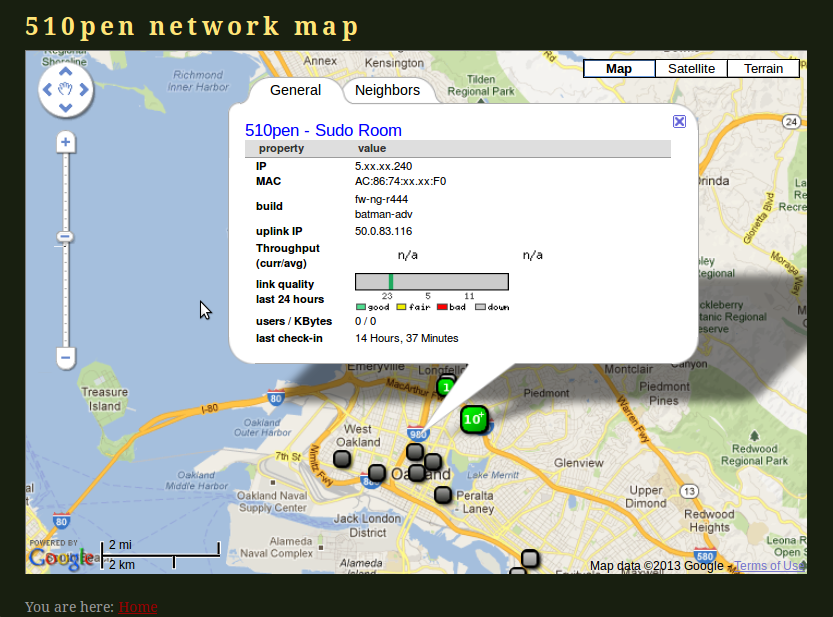 510pen Network Map, with currently-inactive sudo room node information displayed. 510pen is an East Bay community mesh network started by Mark Burdett in 2009. Currently, most of the nodes that were set up between 2009 and 2011 are inactive and in need of tech support. As of last week, we’ve begun meeting weekly at sudo room to discuss basic hows and whys of community mesh networks; wireless network hardware and software; how various community wireless efforts can cooperate and collaborate; models for organic growth, organization, support and sustainability; and how we can join forces with local residents, small businesses, non-profits, municipalities and anyone else to build a ubiquitous community mesh network.
Oakland Wiki is a LocalWiki repository for documenting the infrastructure, communities, and history of Oakland. Oakland Wiki hosts weekly edit-a-thons at the Oakland History Museum, where older residents / historians meet with the Oakland Wiki team to document the history of Oakland. Oakland Wiki is also hosting a civic data session at Open Data Day on February 23rd. The goal of this session is to provide a qualitative focus to an otherwise quantitatively-focused event, encouraging the contribution of information about city council, city policies, politics, and key figures in the city – essentially creating narratives around the past, present, and future of the city in an accessible and historically-rich manner.
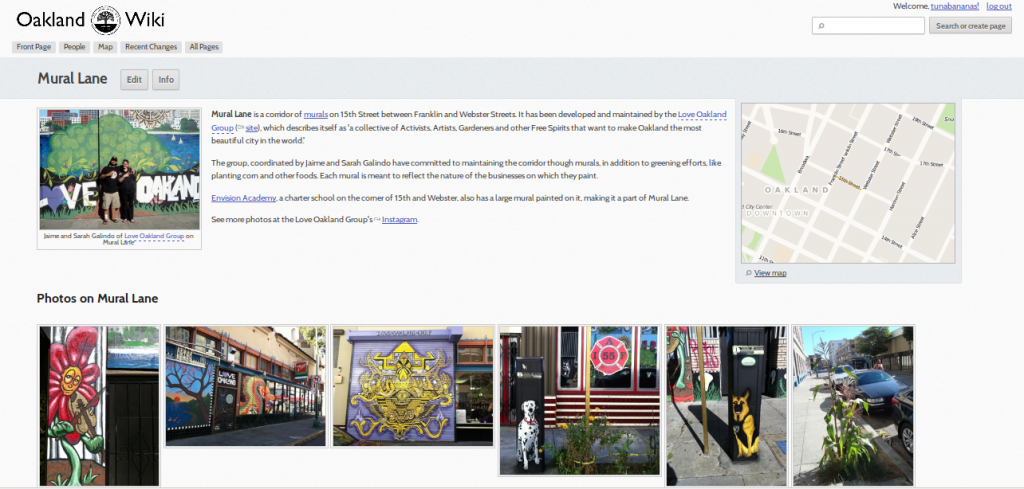 Oakland Wiki: Mural Lane The Open Oakland Digital Divide Group is a collaborative effort to coordinate the various organizations and individuals working on digital divide issues in Oakland. Spawned out of a session at CityCamp Oakland last December, the group consists of local citizens, technologists, and community change workers interested in creating solutions for effectively addressing the digital divide in Oakland. At our first meeting, held on January 24th, we articulated a few tangible goals to work on: individually reaching out to preexisting groups addressing digital divide issues to assess their needs and available resources; group field trips, visiting for instance a local swap meet where broken computers are donated to a group that turns them into working machines; and creating a central directory of digital divide resources for the city, including for instance a map of local, free tech meetups.
These are just a few of the most prominent players and projects as we move forward in developing relationships with community organizations and neighborhood groups. I will continue to transparently document my ongoing research progress at the Tidepools Wiki, and welcome your comments and contributions in the comments of this post!
|
|
